Chapter 11系统功能语言学简介
- 格式:doc
- 大小:97.50 KB
- 文档页数:10
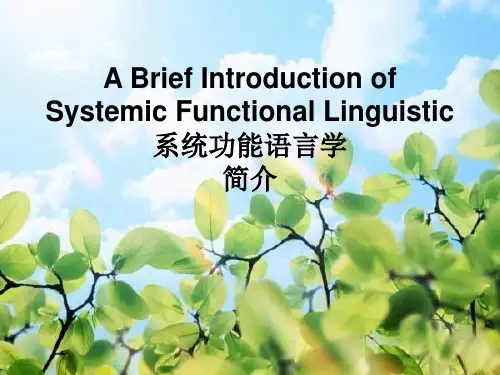
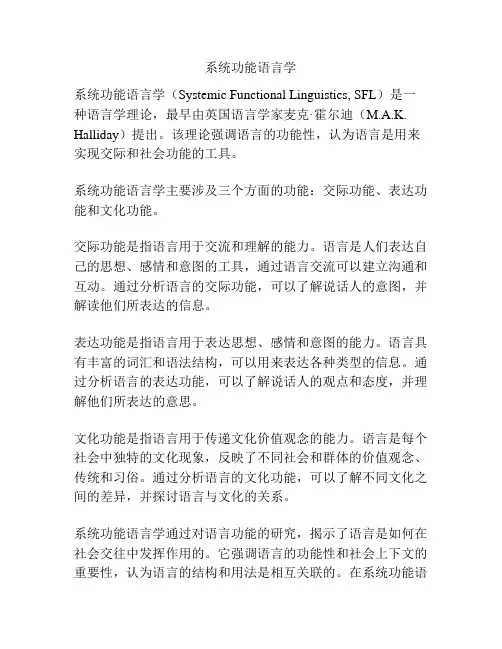
系统功能语言学系统功能语言学(Systemic Functional Linguistics, SFL)是一种语言学理论,最早由英国语言学家麦克·霍尔迪(M.A.K. Halliday)提出。
该理论强调语言的功能性,认为语言是用来实现交际和社会功能的工具。
系统功能语言学主要涉及三个方面的功能:交际功能、表达功能和文化功能。
交际功能是指语言用于交流和理解的能力。
语言是人们表达自己的思想、感情和意图的工具,通过语言交流可以建立沟通和互动。
通过分析语言的交际功能,可以了解说话人的意图,并解读他们所表达的信息。
表达功能是指语言用于表达思想、感情和意图的能力。
语言具有丰富的词汇和语法结构,可以用来表达各种类型的信息。
通过分析语言的表达功能,可以了解说话人的观点和态度,并理解他们所表达的意思。
文化功能是指语言用于传递文化价值观念的能力。
语言是每个社会中独特的文化现象,反映了不同社会和群体的价值观念、传统和习俗。
通过分析语言的文化功能,可以了解不同文化之间的差异,并探讨语言与文化的关系。
系统功能语言学通过对语言功能的研究,揭示了语言是如何在社会交往中发挥作用的。
它强调语言的功能性和社会上下文的重要性,认为语言的结构和用法是相互关联的。
在系统功能语言学的理论框架下,语言被视为一种社会实践,其目的是与他人进行交流。
系统功能语言学的研究方法主要是通过对语言文本的分析和解释来揭示语言的功能。
研究者通常会分析文本中的语法结构、语义意义和语用功能,并将其与具体的社会和文化背景联系起来。
通过这种分析,可以揭示语言和社会之间的相互关系,并提供对语言使用的深入认识。
总之,系统功能语言学是一种关注语言功能和社会实践的语言学理论。
它强调语言的交际功能、表达功能和文化功能,并通过对语言文本的分析,揭示了语言在社会交往中的作用。
系统功能语言学为我们理解和解释语言现象提供了新的视角,对于语言学和社会学的研究具有重要意义。
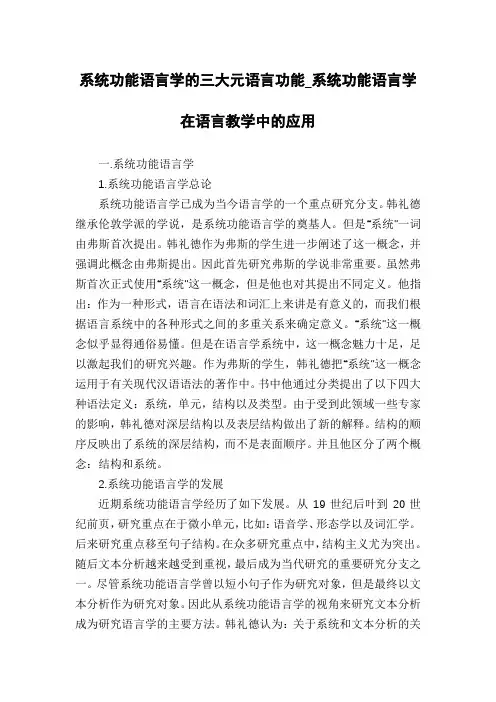
系统功能语言学的三大元语言功能_系统功能语言学在语言教学中的应用一.系统功能语言学1.系统功能语言学总论系统功能语言学已成为当今语言学的一个重点研究分支。
韩礼德继承伦敦学派的学说,是系统功能语言学的奠基人。
但是“系统”一词由弗斯首次提出。
韩礼德作为弗斯的学生进一步阐述了这一概念,并强调此概念由弗斯提出。
因此首先研究弗斯的学说非常重要。
虽然弗斯首次正式使用“系统”这一概念,但是他也对其提出不同定义。
他指出:作为一种形式,语言在语法和词汇上来讲是有意义的,而我们根据语言系统中的各种形式之间的多重关系来确定意义。
“系统”这一概念似乎显得通俗易懂。
但是在语言学系统中,这一概念魅力十足,足以激起我们的研究兴趣。
作为弗斯的学生,韩礼德把“系统”这一概念运用于有关现代汉语语法的著作中。
书中他通过分类提出了以下四大种语法定义:系统,单元,结构以及类型。
由于受到此领域一些专家的影响,韩礼德对深层结构以及表层结构做出了新的解释。
结构的顺序反映出了系统的深层结构,而不是表面顺序。
并且他区分了两个概念:结构和系统。
2.系统功能语言学的发展近期系统功能语言学经历了如下发展。
从19世纪后叶到20世纪前页,研究重点在于微小单元,比如:语音学、形态学以及词汇学。
后来研究重点移至句子结构。
在众多研究重点中,结构主义尤为突出。
随后文本分析越来越受到重视,最后成为当代研究的重要研究分支之一。
尽管系统功能语言学曾以短小句子作为研究对象,但是最终以文本分析作为研究对象。
因此从系统功能语言学的视角来研究文本分析成为研究语言学的主要方法。
韩礼德认为:关于系统和文本分析的关系,不考虑上下文来描述语言是没有用处的,反之亦然。
上下文更像一道程序,而非一团乱麻。
同样,我们可能会分析说话者在说话过程中所选择以及摒弃的内容。
讲话者最终说出的话,也就是众多可能用的表达中所选择出的一种。
对电话另一端的人,我们可以有诸多回话。
想要表达自己的意思,可能也会有各种方式。

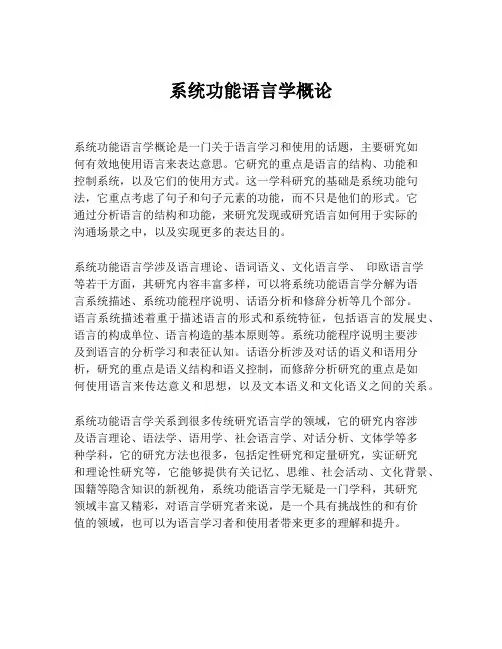
系统功能语言学概论
系统功能语言学概论是一门关于语言学习和使用的话题,主要研究如
何有效地使用语言来表达意思。
它研究的重点是语言的结构、功能和
控制系统,以及它们的使用方式。
这一学科研究的基础是系统功能句法,它重点考虑了句子和句子元素的功能,而不只是他们的形式。
它
通过分析语言的结构和功能,来研究发现或研究语言如何用于实际的
沟通场景之中,以及实现更多的表达目的。
系统功能语言学涉及语言理论、语词语义、文化语言学、印欧语言学
等若干方面,其研究内容丰富多样,可以将系统功能语言学分解为语
言系统描述、系统功能程序说明、话语分析和修辞分析等几个部分。
语言系统描述着重于描述语言的形式和系统特征,包括语言的发展史、语言的构成单位、语言构造的基本原则等。
系统功能程序说明主要涉
及到语言的分析学习和表征认知。
话语分析涉及对话的语义和语用分析,研究的重点是语义结构和语义控制,而修辞分析研究的重点是如
何使用语言来传达意义和思想,以及文本语义和文化语义之间的关系。
系统功能语言学关系到很多传统研究语言学的领域,它的研究内容涉
及语言理论、语法学、语用学、社会语言学、对话分析、文体学等多
种学科,它的研究方法也很多,包括定性研究和定量研究,实证研究
和理论性研究等,它能够提供有关记忆、思维、社会活动、文化背景、国籍等隐含知识的新视角,系统功能语言学无疑是一门学科,其研究
领域丰富又精彩,对语言学研究者来说,是一个具有挑战性的和有价
值的领域,也可以为语言学习者和使用者带来更多的理解和提升。
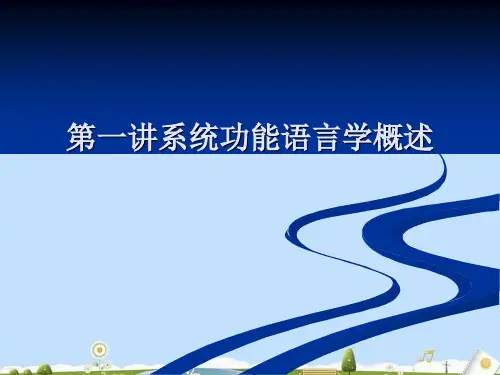
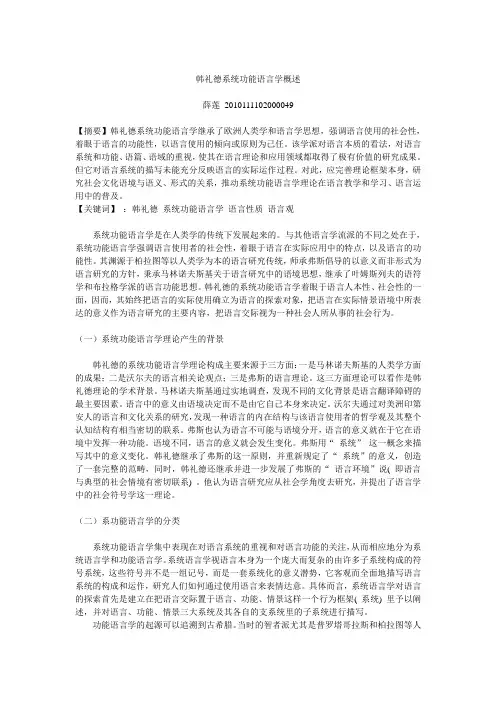
韩礼德系统功能语言学概述薛莲2010111102000049【摘要】韩礼德系统功能语言学继承了欧洲人类学和语言学思想,强调语言使用的社会性,着眼于语言的功能性,以语言使用的倾向或原则为己任。
该学派对语言本质的看法,对语言系统和功能、语篇、语域的重视,使其在语言理论和应用领域都取得了极有价值的研究成果。
但它对语言系统的描写未能充分反映语言的实际运作过程。
对此,应完善理论框架本身,研究社会文化语境与语义、形式的关系,推动系统功能语言学理论在语言教学和学习、语言运用中的普及。
【关键词】:韩礼德系统功能语言学语言性质语言观系统功能语言学是在人类学的传统下发展起来的。
与其他语言学流派的不同之处在于,系统功能语言学强调语言使用者的社会性,着眼于语言在实际应用中的特点,以及语言的功能性。
其渊源于柏拉图等以人类学为本的语言研究传统,师承弗斯倡导的以意义而非形式为语言研究的方针,秉承马林诺夫斯基关于语言研究中的语境思想,继承了叶姆斯列夫的语符学和布拉格学派的语言功能思想。
韩礼德的系统功能语言学着眼于语言人本性、社会性的一面,因而,其始终把语言的实际使用确立为语言的探索对象,把语言在实际情景语境中所表达的意义作为语言研究的主要内容,把语言交际视为一种社会人所从事的社会行为。
(一)系统功能语言学理论产生的背景韩礼德的系统功能语言学理论构成主要来源于三方面:一是马林诺夫斯基的人类学方面的成果;二是沃尔夫的语言相关论观点;三是弗斯的语言理论。
这三方面理论可以看作是韩礼德理论的学术背景。
马林诺夫斯基通过实地调查,发现不同的文化背景是语言翻译障碍的最主要因素。
语言中的意义由语境决定而不是由它自己本身来决定。
沃尔夫通过对美洲印第安人的语言和文化关系的研究,发现一种语言的内在结构与该语言使用者的哲学观及其整个认知结构有相当密切的联系。
弗斯也认为语言不可能与语境分开,语言的意义就在于它在语境中发挥一种功能。
语境不同,语言的意义就会发生变化。
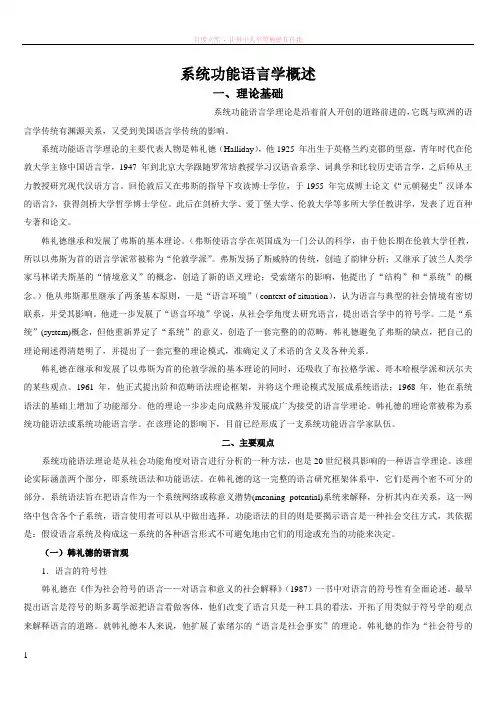
系统功能语言学概述一、理论基础系统功能语言学理论是沿着前人开创的道路前进的,它既与欧洲的语言学传统有渊源关系,又受到美国语言学传统的影响。
系统功能语言学理论的主要代表人物是韩礼德(Halliday),他1925 年出生于英格兰约克郡的里兹,青年时代在伦敦大学主修中国语言学,1947 年到北京大学跟随罗常培教授学习汉语音系学、词典学和比较历史语言学,之后师从王力教授研究现代汉语方言。
回伦敦后又在弗斯的指导下攻读博士学位,于1955 年完成博士论文《“元朝秘史”汉译本的语言》,获得剑桥大学哲学博士学位。
此后在剑桥大学、爱丁堡大学、伦敦大学等多所大学任教讲学,发表了近百种专著和论文。
韩礼德继承和发展了弗斯的基本理论。
(弗斯使语言学在英国成为一门公认的科学,由于他长期在伦敦大学任教,所以以弗斯为首的语言学派常被称为“伦敦学派”。
弗斯发扬了斯威特的传统,创造了韵律分析;又继承了波兰人类学家马林诺夫斯基的“情境意义”的概念,创造了新的语义理论;受索绪尔的影响,他提出了“结构”和“系统”的概念。
)他从弗斯那里继承了两条基本原则,一是“语言环境”(context of situation),认为语言与典型的社会情境有密切联系,并受其影响。
他进一步发展了“语言环境”学说,从社会学角度去研究语言,提出语言学中的符号学。
二是“系统”(system)概念,但他重新界定了“系统”的意义,创造了一套完整的的范畴。
韩礼德避免了弗斯的缺点,把自己的理论阐述得清楚明了,并提出了一套完整的理论模式,准确定义了术语的含义及各种关系。
韩礼德在继承和发展了以弗斯为首的伦敦学派的基本理论的同时,还吸收了布拉格学派、哥本哈根学派和沃尔夫的某些观点。
1961 年,他正式提出阶和范畴语法理论框架,并将这个理论模式发展成系统语法;1968 年,他在系统语法的基础上增加了功能部分。
他的理论一步步走向成熟并发展成广为接受的语言学理论。
韩礼德的理论常被称为系统功能语法或系统功能语言学。
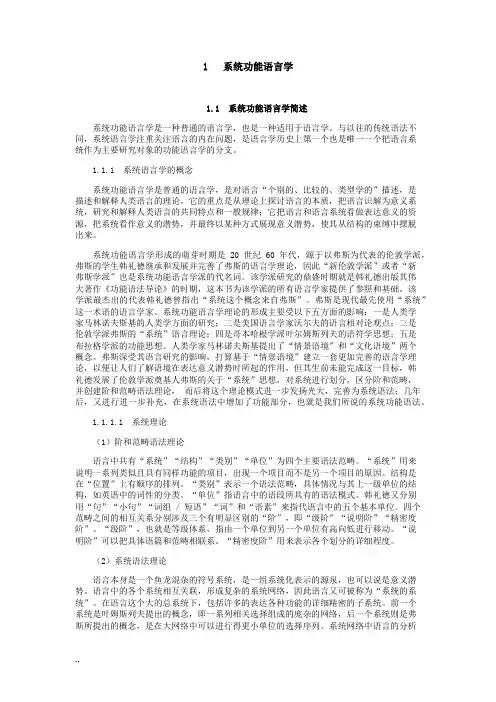
1系统功能语言学1.1 系统功能语言学简述系统功能语言学是一种普通的语言学,也是一种适用于语言学。
与以往的传统语法不同,系统语言学注重关注语言的内在问题,是语言学历史上第一个也是唯一一个把语言系统作为主要研究对象的功能语言学的分支。
1.1.1 系统语言学的概念系统功能语言学是普通的语言学,是对语言“个别的、比较的、类型学的”描述,是描述和解释人类语言的理论。
它的重点是从理论上探讨语言的本质,把语言识解为意义系统,研究和解释人类语言的共同特点和一般规律;它把语言和语言系统看做表达意义的资源,把系统看作意义的潜势,并最终以某种方式展现意义潜势,使其从结构的束缚中摆脱出来。
系统功能语言学形成的萌芽时期是 20 世纪 60 年代,源于以弗斯为代表的伦敦学派,弗斯的学生韩礼德继承和发展并完善了弗斯的语言学理论,因此“新伦敦学派”或者“新弗斯学派”也是系统功能语言学派的代名词。
该学派研究的鼎盛时期就是韩礼德出版其伟大著作《功能语法导论》的时期,这本书为该学派的所有语言学家提供了参照和基础。
该学派最杰出的代表韩礼德曾指出“系统这个概念来自弗斯”。
弗斯是现代最先使用“系统”这一术语的语言学家。
系统功能语言学理论的形成主要受以下五方面的影响:一是人类学家马林诺夫斯基的人类学方面的研究;二是美国语言学家沃尔夫的语言相对论观点;三是伦敦学派弗斯的“系统”语言理论;四是哥本哈根学派叶尔姆斯列夫的语符学思想;五是布拉格学派的功能思想。
人类学家马林诺夫斯基提出了“情景语境”和“文化语境”两个概念。
弗斯深受其语言研究的影响,打算基于“情景语境”建立一套更加完善的语言学理论,以便让人们了解语境在表达意义潜势时所起的作用,但其生前未能完成这一目标,韩礼德发展了伦敦学派奠基人弗斯的关于“系统”思想,对系统进行划分,区分阶和范畴,并创建阶和范畴语法理论,而后将这个理论模式进一步发扬光大,完善为系统语法;几年后,又进行进一步补充,在系统语法中增加了功能部分,也就是我们所说的系统功能语法。
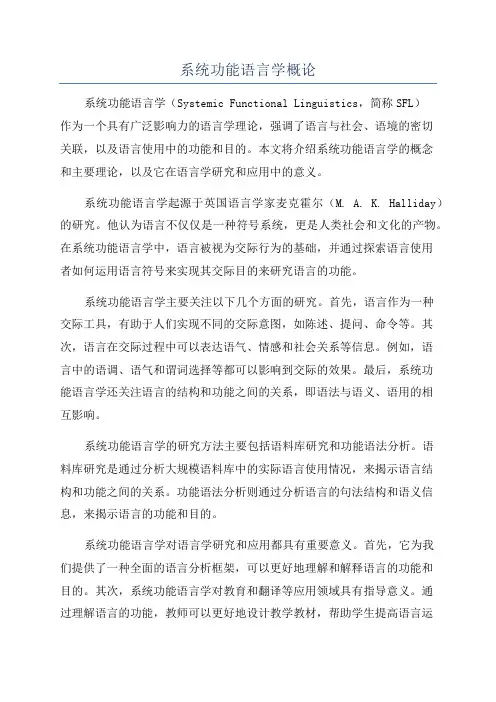
系统功能语言学概论系统功能语言学(Systemic Functional Linguistics,简称SFL)作为一个具有广泛影响力的语言学理论,强调了语言与社会、语境的密切关联,以及语言使用中的功能和目的。
本文将介绍系统功能语言学的概念和主要理论,以及它在语言学研究和应用中的意义。
系统功能语言学起源于英国语言学家麦克霍尔(M. A. K. Halliday)的研究。
他认为语言不仅仅是一种符号系统,更是人类社会和文化的产物。
在系统功能语言学中,语言被视为交际行为的基础,并通过探索语言使用者如何运用语言符号来实现其交际目的来研究语言的功能。
系统功能语言学主要关注以下几个方面的研究。
首先,语言作为一种交际工具,有助于人们实现不同的交际意图,如陈述、提问、命令等。
其次,语言在交际过程中可以表达语气、情感和社会关系等信息。
例如,语言中的语调、语气和谓词选择等都可以影响到交际的效果。
最后,系统功能语言学还关注语言的结构和功能之间的关系,即语法与语义、语用的相互影响。
系统功能语言学的研究方法主要包括语料库研究和功能语法分析。
语料库研究是通过分析大规模语料库中的实际语言使用情况,来揭示语言结构和功能之间的关系。
功能语法分析则通过分析语言的句法结构和语义信息,来揭示语言的功能和目的。
系统功能语言学对语言学研究和应用都具有重要意义。
首先,它为我们提供了一种全面的语言分析框架,可以更好地理解和解释语言的功能和目的。
其次,系统功能语言学对教育和翻译等应用领域具有指导意义。
通过理解语言的功能,教师可以更好地设计教学教材,帮助学生提高语言运用能力。
同时,翻译人员也可以根据不同的交际目的和语境选择合适的翻译策略。
总而言之,系统功能语言学强调了语言与社会、语境的密切关联,以及语言使用中的功能和目的。
通过分析语言范畴、语篇和词语等层面,它为我们提供了一种全面的语言分析方法。
系统功能语言学的研究对于理解语言的功能和目的,以及应用于教育和翻译等领域具有重要意义。
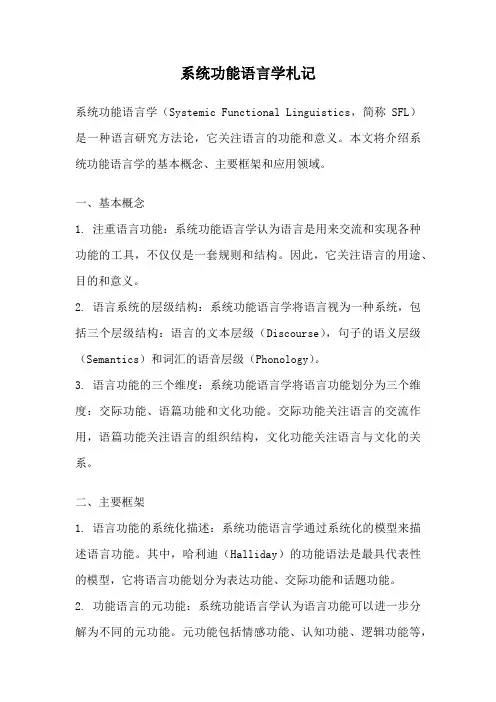
系统功能语言学札记系统功能语言学(Systemic Functional Linguistics,简称SFL)是一种语言研究方法论,它关注语言的功能和意义。
本文将介绍系统功能语言学的基本概念、主要框架和应用领域。
一、基本概念1. 注重语言功能:系统功能语言学认为语言是用来交流和实现各种功能的工具,不仅仅是一套规则和结构。
因此,它关注语言的用途、目的和意义。
2. 语言系统的层级结构:系统功能语言学将语言视为一种系统,包括三个层级结构:语言的文本层级(Discourse),句子的语义层级(Semantics)和词汇的语音层级(Phonology)。
3. 语言功能的三个维度:系统功能语言学将语言功能划分为三个维度:交际功能、语篇功能和文化功能。
交际功能关注语言的交流作用,语篇功能关注语言的组织结构,文化功能关注语言与文化的关系。
二、主要框架1. 语言功能的系统化描述:系统功能语言学通过系统化的模型来描述语言功能。
其中,哈利迪(Halliday)的功能语法是最具代表性的模型,它将语言功能划分为表达功能、交际功能和话题功能。
2. 功能语言的元功能:系统功能语言学认为语言功能可以进一步分解为不同的元功能。
元功能包括情感功能、认知功能、逻辑功能等,它们共同构成了语言的多维功能体系。
3. 语篇分析的功能:系统功能语言学强调对语篇的功能分析。
语篇分析关注文本的结构和组织,通过分析语篇的功能来揭示语言的意义和目的。
三、应用领域1. 教育和语言教学:系统功能语言学为语言教学提供了新的理论基础和方法。
它可以帮助教师了解学生语言能力的发展过程,设计有效的教学活动,提高学生的语言能力。
2. 社会语言学:系统功能语言学可以研究不同社会群体之间的语言差异和语言变化。
通过分析语言的功能和意义,可以揭示语言与社会、文化的关系。
3. 翻译和跨文化交际:系统功能语言学可以帮助翻译者理解不同语言之间的差异和异同,从而更好地进行翻译工作。
系统功能语言学概述系统功能语言学(Systemic Functional Linguistics,简称SFL)是现代语言学中的一个分支领域,起源于20世纪60年代的英国。
它的理论基础是以英国语言学家迈克尔·霍尔迪(Michael Halliday)为首的一群学者发展起来的,主要通过研究语言的实际功能和用途,来揭示语言的本质和结构。
系统功能语言学的核心概念是“功能”,这意味着语言的重要特征是它的实际使用方式,而不仅仅是其形式结构。
与传统的形式主义语言学相比,SFL强调语言的社会和交际功能。
它将语言视为人类社会活动的重要组成部分,通过语言的途径来实现和反映社会的目标和需求。
因此,SFL主张在研究语言时,应该将语言放置在具体的社会背景中,并关注语言的真实用途。
SFL理论框架包括三个层次:语言的文本层面、意义的交际层面以及社会语言实践的层面。
这三个层次构成了构架的核心。
在文本层面,SFL关注如何通过选择和组织语言单位来创造意义的。
在意义的交际层面,SFL关注语言如何用于社会交流和构建社会关系。
在社会语言实践的层面,SFL关注语言如何反映和实现社会目标和需求。
SFL强调语言的系统性。
它认为每一种语言都是一个复杂而有机的系统,由不同的组成要素互相作用构成。
SFL将语言单位分为三大类:语言功能、语言结构和语言实现。
语言功能包括三个维度:情感、说服和交际。
语言结构包括文法、词汇和音系。
语言实现包括言语、文本和对话。
这些要素之间相互作用,形成了语言系统。
SFL还引入了“言语功能”的概念,即语言在具体语境中实现特定目标和功能的能力。
这个概念体现了语言使用的实际目的和需求。
SFL认为语言具有多种的言语功能,如:陈述、询问、命令、请求等,每种功能都对应着特定的语言结构和表达方式。
在系统功能语言学中,文本分析是一种重要的研究方法。
SFL的文本分析着重于揭示语言单位之间的相互关系和语篇结构。
通过文本分析,研究者可以深入了解语言的功能、结构和实现方式,从而揭示语言的意义和社会功能。
系统功能语言学1 基本概念系统功能语言学(system-functional linguistics)为英国著名的语言学家韩礼德Halliday创立。
英文论点如下:Systemic Grammar is different from other linguistic theories in the following aspects.Firstly, it attaches great importance to the sociological aspects of language.Secondly, it views language as a form of doing rather than a form of knowing. It distinguishes linguistic behaviour potential from actual linguistic behaviour.Thirdly, it gives a relatively high priority to description of the characteristics of particular languages and particular varieties of languages.Fourthly, it explains a number of aspects of language in terms of clines (i.e. ungrammatical →more unusual →less unusual →less usual→grammatical).Fifthly, it seeks verification of its hypotheses by means of observation from texts and by means of statistical techniques.Lastly, it has as its central category the category of the system.中文翻译:相对于其它语言理论,系统功能语法有以下几个特征:首先,它非常关注语言的社会属性,如何实现社会功能。
1系统功能语言学1.1 系统功能语言学简述系统功能语言学是一种普通的语言学,也是一种适用于语言学。
与以往的传统语法不同,系统语言学注重关注语言的内在问题,是语言学历史上第一个也是唯一一个把语言系统作为主要研究对象的功能语言学的分支。
精品文档,你值得期待1.1.1 系统语言学的概念系统功能语言学是普通的语言学,是对语言“个别的、比较的、类型学的”描述,是描述和解释人类语言的理论。
它的重点是从理论上探讨语言的本质,把语言识解为意义系统,研究和解释人类语言的共同特点和一般规律;它把语言和语言系统看做表达意义的资源,把系统看作意义的潜势,并最终以某种方式展现意义潜势,使其从结构的束缚中摆脱出来。
系统功能语言学形成的萌芽时期是 20 世纪 60 年代,源于以弗斯为代表的伦敦学派,弗斯的学生韩礼德继承和发展并完善了弗斯的语言学理论,因此“新伦敦学派”或者“新弗斯学派”也是系统功能语言学派的代名词。
该学派研究的鼎盛时期就是韩礼德出版其伟大著作《功能语法导论》的时期,这本书为该学派的所有语言学家提供了参照和基础。
该学派最杰出的代表韩礼德曾指出“系统这个概念来自弗斯”。
弗斯是现代最先使用“系统”这一术语的语言学家。
系统功能语言学理论的形成主要受以下五方面的影响:一是人类学家马林诺夫斯基的人类学方面的研究;二是美国语言学家沃尔夫的语言相对论观点;三是伦敦学派弗斯的“系统”语言理论;四是哥本哈根学派叶尔姆斯列夫的语符学思想;五是布拉格学派的功能思想。
人类学家马林诺夫斯基提出了“情景语境”和“文化语境”两个概念。
弗斯深受其语言研究的影响,打算基于“情景语境”建立一套更加完善的语言学理论,以便让人们了解语境在表达意义潜势时所起的作用,但其生前未能完成这一目标,韩礼德发展了伦敦学派奠基人弗斯的关于“系统”思想,对系统进行划分,区分阶和范畴,并创建阶和范畴语法理论,而后将这个理论模式进一步发扬光大,完善为系统语法;几年后,又进行进一步补充,在系统语法中增加了功能部分,也就是我们所说的系统功能语法。
Chapter 10: Systemic-Functional Grammar 1. IntroductionIn this chapter, we will give a brief introduction to the work of M.A.K. Halliday and Systemic-Functional grammar. Systemic-Functional Grammar is also named as Systemic-Functional Linguistics.Michael Alexander Kirkwood Halliday has sought to create an approach to linguistics that treats language as foundational for the building of human experience. His insights and publications form an approach called systemic-functional linguistics. Halliday's work stresses that language is closely associated with meaning. Systemic-functional linguistics (SFL), as its name suggests, considers function and semantics as the basis of human language and communicative activity. Unlike structural approaches that privilege syntax, SFL-oriented linguists begin an analysis with social context and then look at how language acts upon, and is constrained and influenced by, this social context. A key concept in Halliday's approach is the "context of situation" which obtains "through a systematic relationship between the social environment on the one hand, and the functional organization of language on the other" (Halliday, 1985:11).According to Halliday’s systemic-functional linguistics, language, a kind of tool used for human communication, has many functions. In its system, language has three matafunctions, which are ideational metafunction, interpersonal metafunction and textual metafunction. Each of the three metafunctions is about a different aspect of the world, and is concerned with a different mode of meaning of clauses.2. Ideational MetafunctionThe ideational metafunction refers to the fact that language is used to express people’s experiences in the real world including the experiences in their internal world or the experiences in their mind. Namely, ideational metafunction is about the natural world in the broadest sense, including our own consciousness, and is concerned with clauses as representations. Ideational metafunction has three sub-systems, which are transitivity, voice and polarity. Here, we just talk about the first system, transitivity.Transitivity is a semantic system to show the ideational metafunction of language.It divides people’s experiences in the natural world and in their internal world into six processes. In each process, both the participant and the circumstantial element are presented. The six processes are material process, mental process, relational process, behavioural process, verbal process and existential process.Material process refers to the process of doing something. The process consists of process verbs, often verbs of action, Actor, and Goal.Tom broke the glass.3. Interpersonal metafunctionIn addition to the use of language to talk about their experiences about the real world and their internal world, people also use language to communicate with other people or they just use language to build the relations between them. The function of language in this aspect is called interpersonal metafunction. The interpersonal metafunction is about the social world, especially the relationship between speaker and hearer, and is concerned with clauses as exchanges. Language can often indicates the speaker’s status, social position, attitude, motivation, and it can show the relationship between speaker and listener.Mood consisting of Subject and Finite is essential factor when we analyze the interpersonal metafunction.4. Textual metafunctionApart from the metafunctions talked above, we still use language to organize the information or linguistic elements into a complete text or discourse. This is the textual metafunction of language. Therefore, the textual metafunction is about the verbal world, especially the flow of information in a text, and is concerned with clauses as messages.There are three sub-systems in the textual metafunction, which are Theme-Rheme system, Given information and New information system and cohesion system. Theme-Rheme system is also called thematic structure, and Given information and New information system is also called information structure. Here, we will mainly talk about the Theme-Rheme system.Theme is the starting point of the clause message realized in English by first position in a clause must contain a participant, process or circumstance includes any element preceding the first participant, process or circumstance. When Theme is decided, the other elements in a clause are rheme.5. Application of systemic-functional linguisticsSystemic-Functional linguistics can be used in many fields, such as translation, language teaching and language learning, etc. However, as Halliday points out, he builds systemic-functional grammar to provide a theory for discourse analysis. There are many theories and methods are being used in discourse analysis, and the method by using systemic-functional grammar is called functional discourse analysis.MetafunctionsHalliday developed a theory of the fundamental functions of language, in which he analysed lexicogrammar into three broad metafunctions: ideational, interpersonal and textual. Each of the three metafunctions is about a different aspect of the world, and is concerned with a different mode of meaning of clauses. The ideational metafunction is about the natural world in the broadest sense, including our own consciousness, and is concerned with clauses as representations. The interpersonal metafunction is about the social world, especially the relationship between speaker and hearer, and is concerned with clauses as exchanges. The textual metafunction is about the verbal world, especially the flow of information in a text, and is concerned with clauses as messages. Malinowski's influence (see Figure 1.1) seems clear here: the ideational metafunction relates to the context of culture, the interpersonal metafunction relates to the context of situation, and the textual metafunction relates to the verbal context.In each metafunction an analysis of a clause gives a different kind of structure composed from a different set of elements. In the ideational metafunction, a clause is analysed into Process, Participants and Circumstances, with different participant types for different process types (as in Case Grammar). In the interpersonal metafunction, a clause is analysed into Mood and Residue, with the mood element further analysed into Subject and Finite. In the textual metafunction, a clause is analysed into Theme and Rheme (as in the Prague School).Figure 1.7: Metafunctional layeringFigure 1.7, taken from [Matthiessen & Bateman 1991], shows an analysis of the sentence ``In this job, Anne, we're working with silver'' into three different structures in the three metafunctions. Thiskind of diagram is called a ``metafunctional layering'' diagram in SFG, but the metafunctions do not have any kind of relative ``depth'', rather they are different dimensions.The metafunctional theory is part of the ``functional'' side of SFG, but it is also important in the ``systemic'' side of SFG. Each metafunction has a principal system in the networks for clauses, verbal groups and nominal groups. For example the TRANSITIVITY system is the principal system for the ideational metafunction in the clause network. These principal systems are shown in Figure 1.8, taken from [Matthiessen & Bateman 1991].Figure 1.8: Principal systemsAn important theoretical point is that in general, in the system networks, the systems within each metafunction are closely interconnected, but are largely independent of systems in the other metafunctions. System interconnections across metafunctions are rare. This is illustrated inFigure 1.9, taken from [Matthiessen & Halliday to appear].Figure 1.9: Independence of metafunctionsIn this network fragment, there are normal dependency relationships within the MOOD region of theinterpersonal metafunction, between the MOOD-TYPE and INDICATIVE-TYPE systems andbetween the INDICATIVE-TYPE and INTERROGA TIVE-TYPE systems, and there is also a furtherinterconnection: the TAGGING system can be entered either from the imperative feature of theMOOD-TYPE system or from the declarative feature of the INDICATIVE-TYPE system. But thereare no interconnections at all between the MOOD region of the interpersonal metafunction and theTRANSITIVITY region of the ideational metafunction.The textual metafunction"The textual metafunction creates discourse""Of the various structures which, when mapped on to each other, make up a clause, we will consider first the one which gives the clause its character as a message. This is known as thematic structure. We may assume that in all languages the clause has the character of a message: it has some form of organization giving it the status of a communicative event. But there are different ways in which this may be achieved. In English, as in many other languages, the clause is organized as a message by having a special status assigned to one part of it. One element in the clause is enunciated as the theme; this then combines with the remainder so that the two parts together constitute a message." (Halliday, p 37)creates discourseclause as messagethe linguistic expression of the other two metafunctions (ideational, interpersonal)theme vs. rhemeSubject – grammatical functionActor – doer of the actionTheme –‘what the sentence is about’The chef is preparing dinner in the kitchen.Dinner is being prepared in the kitchen.In the kitchen the chef is preparing dinner.In the kitchen dinner is being prepared by the chef.Definitions of Themethe starting point of the clause messagerealized in English by first position in a clausemust contain a participant, process or circumstanceincludes any element preceding the first participant, process or circumstanceTheme. Textual clause function: the point of departure of the clause as message. It sets up the local context for each clause. This local context often relates to the method of development of the text: the Theme is selected in such a way that it indicates how the clause relates to this method and contributes to the identification of the current step in the development. The term theme has an entirely different meaning in formal grammars (as does the term thematic roles), which has nothing to do with the long tradition of work on theme in Prague School linguistics and other functional traditions. => IFG Chapter 3. => LexCart Section 6.2. (From Christian Matthiessen: Glossary of systemic-functional terms. .au/)Topic. The subject matter of a clause; what it is about – often as one member of the pair topic + comment. Topic corresponds roughly to the experiential part of Theme, Topical theme, in Halliday's analysis of English, but it typically excludes textual and interpersonal Themes. (Sometimes thenotion of given or known is also included in topic, but never in Halliday's Theme.) Cf. IFG p. 39. (From Christian Matthiessen: Glossary of systemic-functional terms. .au/)Theme in declarative sentencesUnmarked (Theme = Subject):The two Indians stood waiting.Nick and his father went into the stern of the boat.The Indian who was rowing them was working very hard.But I will have some photographs taken.Oh, you’re a great man.No, I think it’s pretty easy.There was no need of that.Of course it’s an accident.Marked (Theme ¹Subject):Across the bay they found the other boat.In February 1979 he was awarded the George Cross posthumously.And when you get down there you find he hasn’t actually got any.Inside him was rising an urge to do something, take some action.That I don’t know.What she had felt he never knew.Most troubling of all to some social scientists is the message men get that being a good father means learning how to mother.Theme in interrogative sentencesPolarity (yes/no) questions: unmarked Theme = finite + SubjectAre you interested in syntax?Would you like a cup of tea?Oh, so is that your plan?But don't any of the artist-folk fancy children?By the way, were you serious about moving to Milton Keynes?Wh-questions: unmarked Theme = Wh-wordWhat are you doing here?Where are we going?Then, in the name of goodness, why does she bother?If it's true that contented cows give more milk, why shouldn't happy ball players produce more base hits?Theme in imperative sentencesWake me up before the coffee break.Don’t disturb me while I’m taking a nap.Let’s have a look at this recipe.What elements go into the Theme?The first experiential element in the clause (participant/process/circumstance)Any element preceding the first experiential element in the clause (modal/connective adjuncts, conjunctions, finite, vocative,Thematic equativeWhat he meant by this was that he was no longer an apprentice.What they did was go into the stern of the boat.The reason he asked you where you were going is because he hoped you would be visiting other areas.Theme in clause complexesAs soon as she had pressed the doorbell – it let out a musical jingle – Philippa sensed that the house was empty.Resisting the temptation to peer through the letter-box, she decided to try next door.At least they would know whether Ducton still lived at 41 or where he had gone.Week 7 (14+16. March): "More on thematic analysis": Multiple Theme; Predicated Theme; Theme and given/new; Theme in texts (article by P. Fries)Theme–Rheme analysis of some sentences (Underlined: downranked themes):。